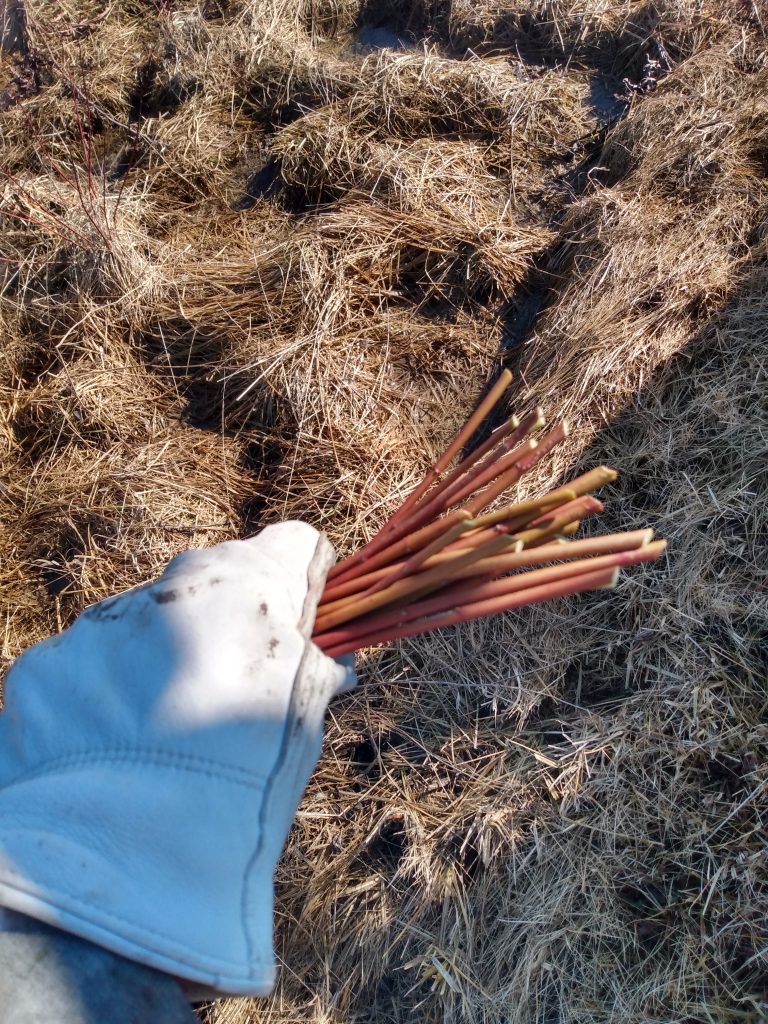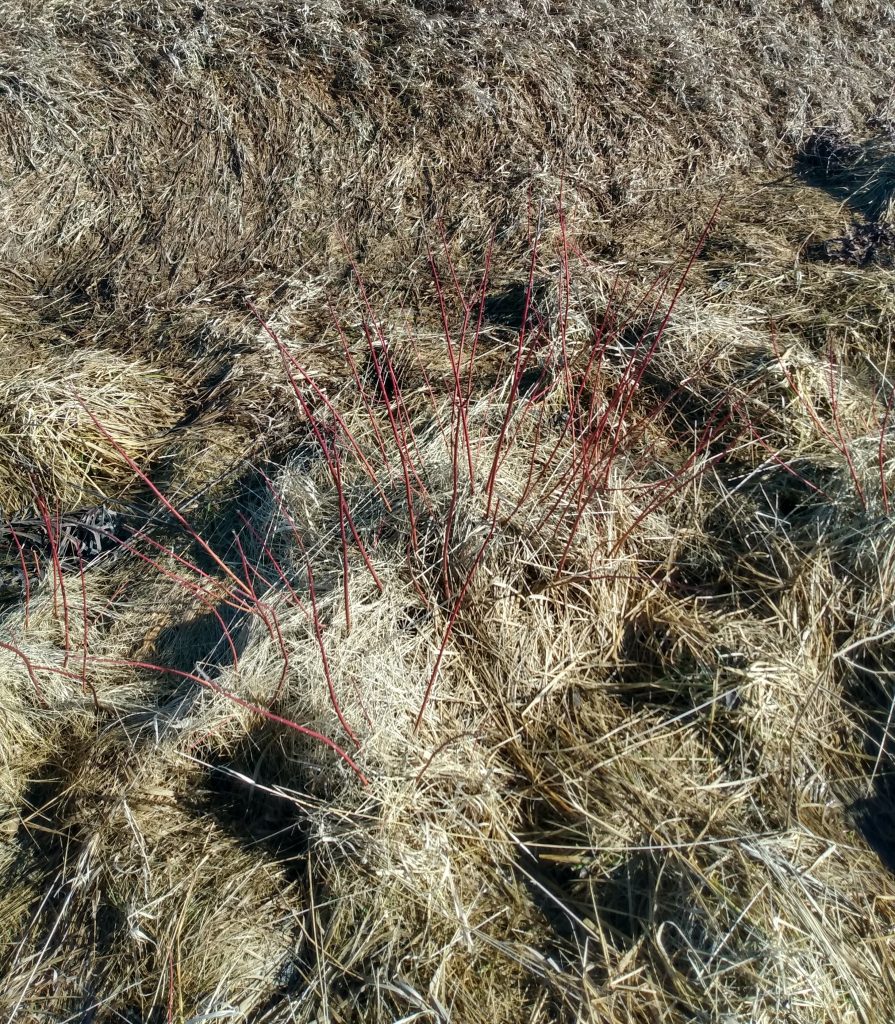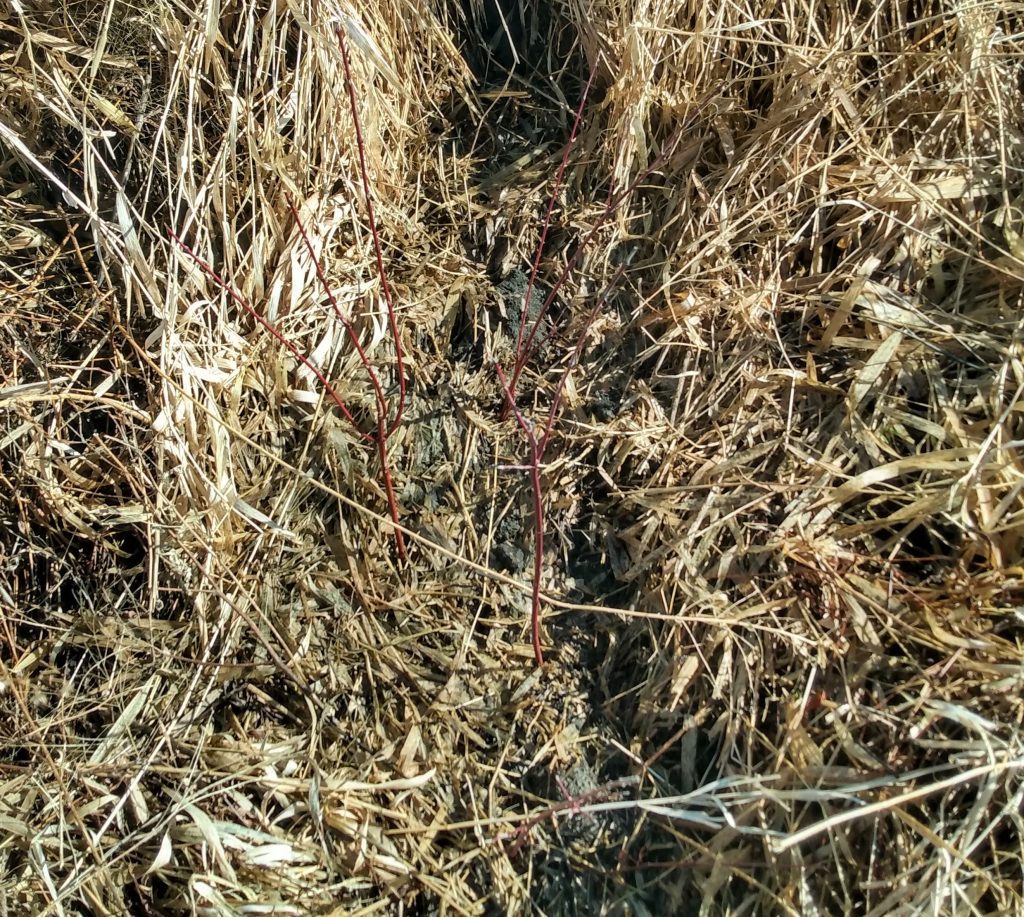This year, I will be trying to do something like weekly updates on this year’s hunt on YouTube. Check out my channel…just search for TomPeplinski and I’ll be there. I do all my own editing and don’t have fancy software … Continue reading
Author Archives: Peppy
2022 Late Muzzy Updates
Gallery
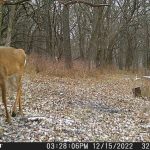
This gallery contains 1 photo.
So far, 2022 has been nothing short of outstanding for Amy and I. What started off kind of slow in early October sure finished strong. Now, as we head into late muzzy, we both once again have buck tags. Going … Continue reading
2022 Archery Review
Gallery
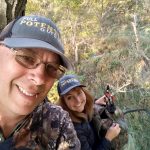
This gallery contains 1 photo.
I promised I’d take some time reviewing the 2022 archery season. So here goes. First, let’s take a look at things I learned or want to improve on for future seasons. What stands out most for me from this season … Continue reading
No Name Shows Back Up
Every year, there are bucks that you saw or had pictures of from the previous year that you hope made it, and then hope they show back up. This year there were a few bucks like that. Ranger topped the list, but then other bucks that we had been following. Gummy. Inside 10. Drop Tine buck. Then there are bucks that are so rare, so elusive or maybe just don’t spend much time on or around your property that you never really know much about them. Last year, this rare buck was a wide and massive 10 point I got one picture of on the neighbor’s farm. That’s it. One picture and never saw him. He was a target buck for me, even though the odds of seeing him were slim.
Then this year, that same big frame 10 shows back up in the form of one early season picture…and then nothing. “So he’s still around” I thought when I got that single picture. Maybe I’ll run into him. Regardless of antler size (and he’s by no means small), a mature buck that spends very little time in and around our hunting grounds is always a target. A home boy might get a pass…simply to let the story and chase play out another year. But not a straggler.
So last night, after letting the home farm food sources sit and soak for what seemed like weeks, we finally got that perfect SW wind I was waiting for to hunt a stand the takes advantage of a ditch crossing and inside corner. The travel pattern at this spot is mostly a bed to feed pattern…and this year we have some standing beans and standing corn just to the east of this stand. The plot is about an acre and a half and was intended to be a destination plot mostly for late muzzy. I had been hunting mostly evening sits and activity in and around food had been phenomenal. Morning and mid-day had been phenomenal too but that was mostly in tight to bedding. Tonight, the play was food. My target buck was Gummy, but this time of year I always, ALWAYS, say that it seems like one buck shows up that wasn’t there all year. It’s the post peak breeding excursion. (I made that up, but that very well could be what is going on.)
(Below is the one and only picture we ever got in 2021 of the buck we are now calling No Name. We never saw this buck all last year)
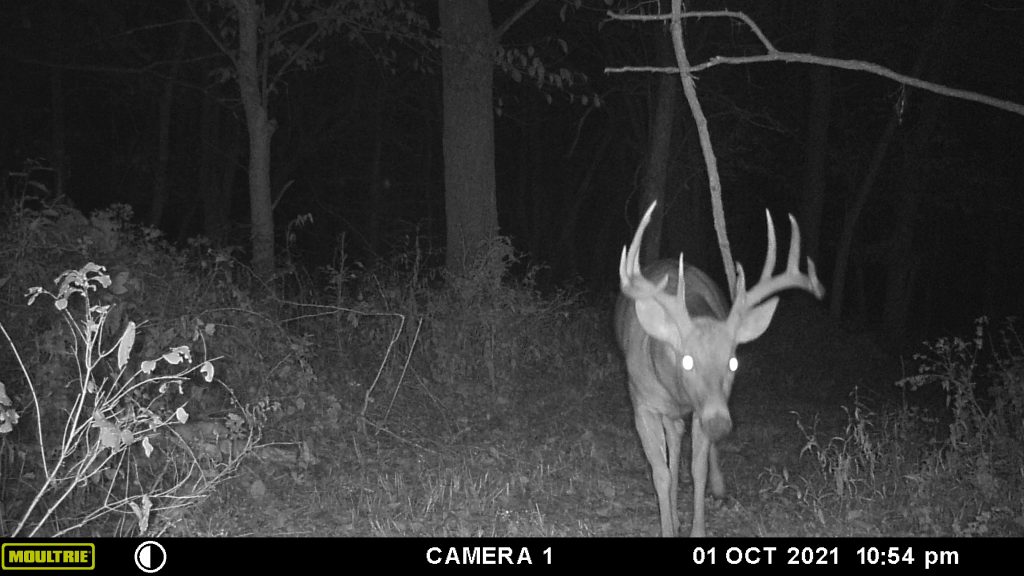
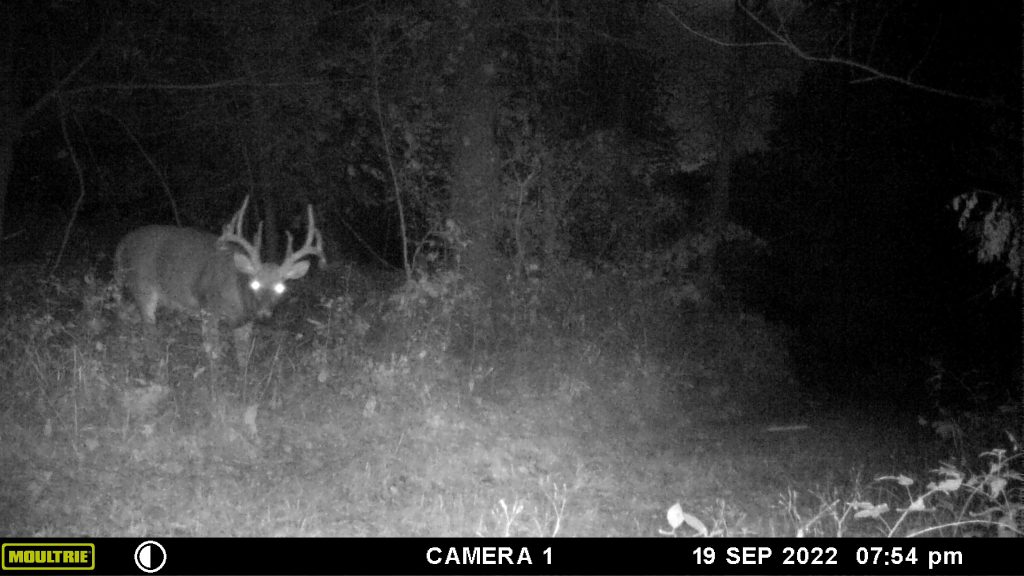
Access to the north ditch crossing stand on the home farm is about the best it can be. You cross a cow pasture down-wind of the stand following a draw that keeps you low and hidden. The stand is located just across the cattle fence allowing you to cross the fence and enter the stand almost immediately. In theory, deer are always in front of you and always up wind. This year, it’s even better as the standing corn blocks any movement you might make while getting in. It’s about as good as it gets. But, deer weren’t using the area too much early on. The standing corn all over in the neighborhood had deer spread out, and then when the corn got combined more activity with raking and bailing of the stalks near this stand just had things too stirred up. That’s why it was soaking, the stand that is.
Last night was perfect. Entry was good. Nice SW winds about 15 mph. Deer kind of sort of returning to a bed to feed pattern with peak breeding just over. Any last remaining hot doe would be gold right now. And, would Gummy show up? At this point, he was the target.
As I settle in early, I start seeing deer almost immediately. First a glimpse of a big buck…nuzzling a doe around in the switchgrass. Only a glimpse…then another better look. It’s a really nice buck I passed once this year. He’s a home boy…he gonna get another pass. Then more does and fawns later in the sit. A little buck, then another making their way from bed to feed on the corn.
The sun was up and bright. At one point, around 3, I had to layer down taking off my down thin layer beneath my coat. Then back to no movement as I watch to see what shows up. The rest of the afternoon went with a glimpse here and there of deer walking around in the bedding area of switch grass, young willow, and wild plum. As the sun finally sets in the west, the wind starts to lay down. It’s the phenomenon I hate as no wind can make your scent disperse and go overwhere. But tonight , the wind stayed, at least a little. Two more bucks are now working their way out from the bedding. It’s a big 10 point and another mature 9 point. The bucks are together almost like they are bachelored back up, but after only a bit they lock antlers. The fight lasts only seconds and then they both turn and walk the other way separate this time. I don’t get a great look at the 10…was it Gummy? “It might have been” is my thinking.
To my right, which is south east, I see movement in the distance. It’s from the bedding area only now it’s closer as this deer is more in the open. I pick up my binoculars to take a look and immediately recognize this buck. It’s “that buck” I say to myself. Not expecting this big framed 10 to be here tonight, to be anywhere for that matter. I spend some precious seconds glassing to make sure my eyes aren’t lying to me as he walks toward me with pretty good determination. He’s closing the distance pretty quick…now the only question is what side of the tree is he coming on?
As he walks right at me the trail forks. He goes right (which is my left) and he leaves me a 20 yard chip shot off my left side. No need to even stand which is always my goal. He goes left, and I’ll have to stand as my only shot is over a large branch coming from my tree. “I’ll stand” I say to myself hedging my bets and making sure I can take a shot either side. As I do, I notice another buck that got in on me while I must have been glassing No Name. It’s the Drop Tine buck. He’s right underneath my stand already but moving past…”please keep going” I’m thinking. He does. Next up…No Name.
As he reaches the fork in the trail, he turns left putting him on my right side. I shift my body in preparation for the shot. The trail he’s taking puts him at 10 yards, but before I get a chance to draw he’s already in the open and coming in fast. Not running, but just chewing up yards faster than I can adjust. I start to pull back and he sees movement and locks up. We are now in that standoff any archery hunter knows about. The tree I’m in is big, and I have it brushed in too with cedars. After only a few seconds, he decides it’s ok. I think Drop Tine moving past convinces him the coast is clear.
As he starts to move again I pull straight back and come to full draw. This time he sees clear movement and spooks just a little bit taking a couple quick steps away. Again, we are in a standoff…only this time I’m already at full draw and he’s broadside. The massive antlers staring right at me, snot running from his nose as he tries desperately to smell me. I settle in behind the front shoulder…low…lower…just at the heart…thwack. I hear it, what sounds like a perfect shot. No Name runs off headed back for cover. As he gets to about 80 yards or so from the stand he goes down. Only, this wasn’t the classic wobble then fall over go down. Instead to me it looks like he bedded down?
I was sure, at least almost sure, the shot was perfect. But I never did see the arrow and by the time he laid down I never got a chance to see where I had hit. My confidence was high, but I had no reason to charge in to get him. I would wait for dark…then wait for the morning to go back!
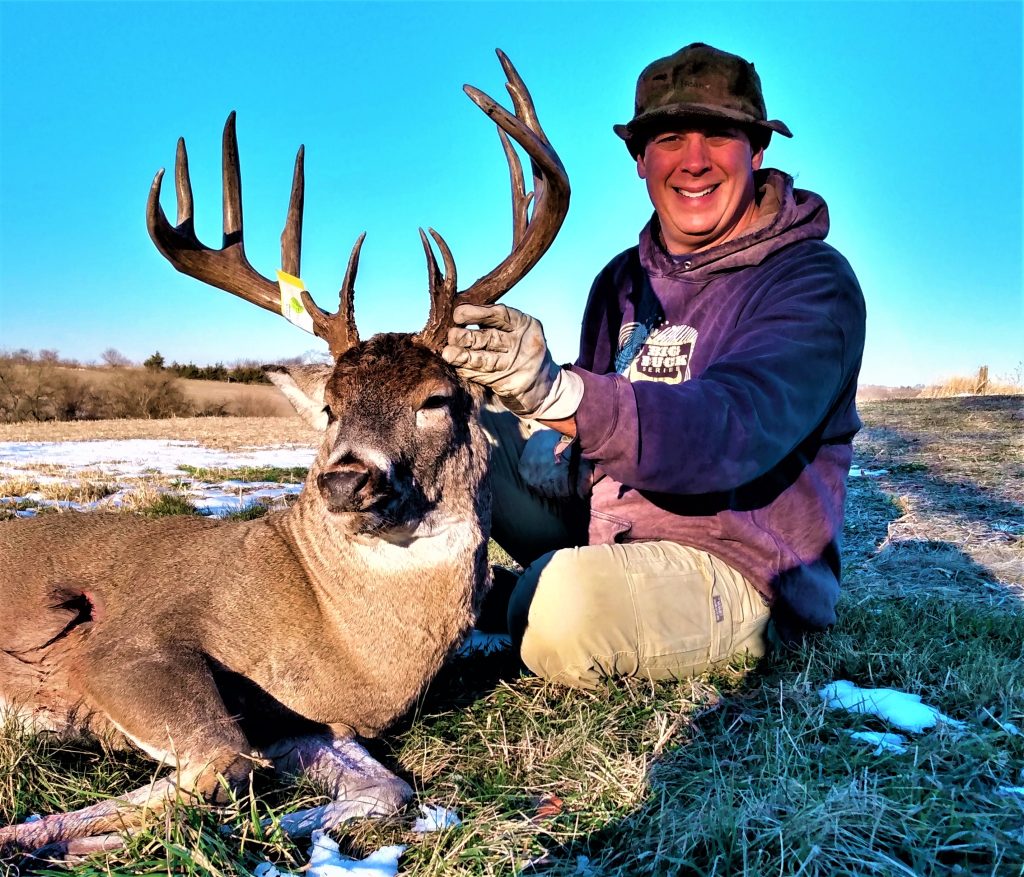
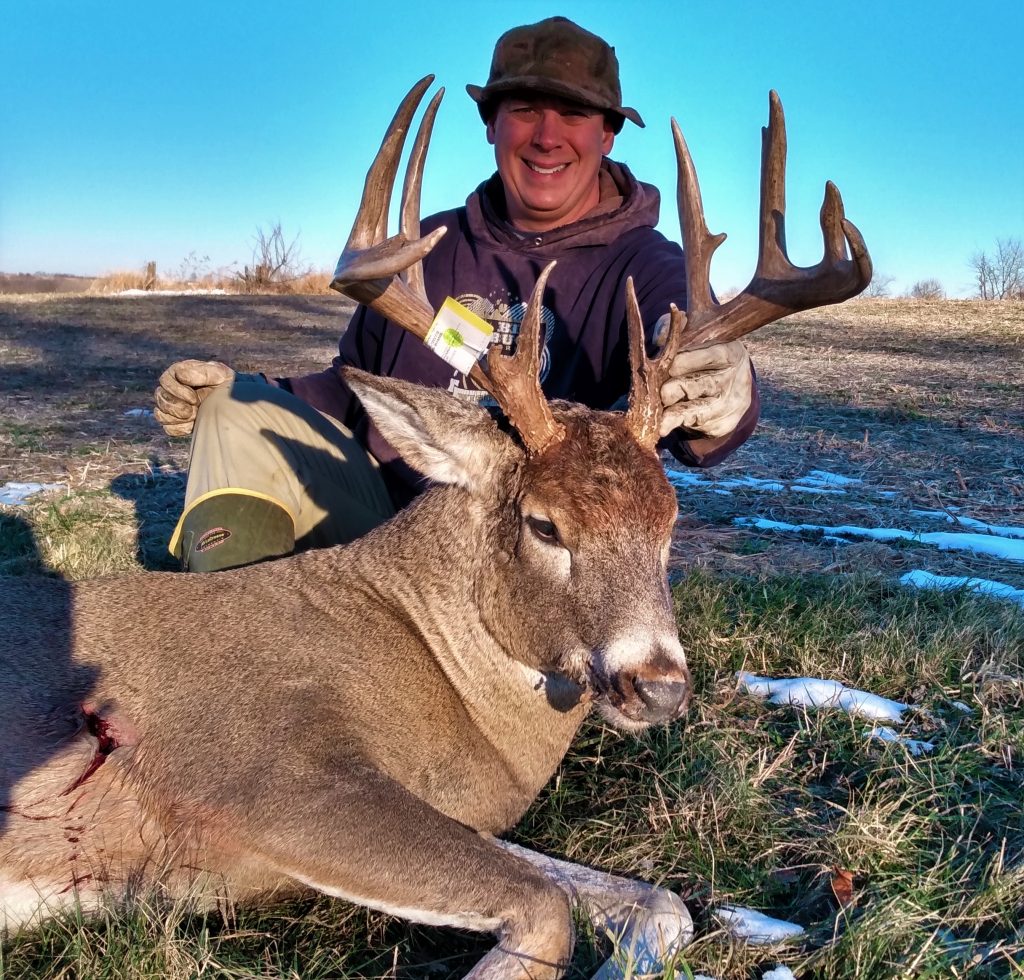
One last thought on No Name. I think it’s more than just a coincidence now, that all three deer that I have a history with that were shot this year (Ranger, Inside 10, and now No Name) all got smaller this year over last. By smaller, I mean their rack was smaller this year. Now, I’m not antler shaming my own deer or that of Zach’s. No, truly these are great bucks. But either a tough winter, or maybe the severe drought pushed antler growth down this year? I’ll let you be the judge of that.
Ok, one last thought. You’ll hear a lot about hunting the “Lock Down” phase of the rut. I can say this…hunting closer and closer to doe bedding will dispel any notion that deer are in the lock down. I”ve been seeing mature bucks almost daily all through the “lock down” That’s been my experience. And, keeping your hunting areas fresh as much as you can help it will also help in making sure you have season long good hunting.
Thank you for following along!
Ranger’s Luck Runs Out
Gallery
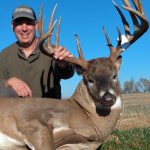
This gallery contains 1 photo.
10/28 Going into the 2022 season, I had one buck on my mind. It was Ranger. A giant, at least a 6 year old typical 12 pointer that Amy first scouted back in 2020. She found the buck while long … Continue reading
Muley Got Throat Punched (Amy’s Description)
Gallery
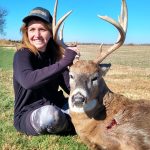
This gallery contains 1 photo.
10/28 We are lucky to have some of the best places in the world to hunt whitetail living in southern Iowa. And, with that being said, we are equally lucky to have friends and neighbors that let us hunt on … Continue reading
2022 Archery Updates
Gallery
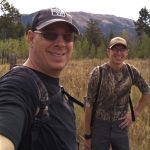
This gallery contains 1 photo.
So, a long off season as usual. Couldn’t quite wait to get back hunting but this fall has been a busy one. First, Forest and I spent 10 days in the mountains of Idaho hunting elk. Forest had a tag, … Continue reading
2022 Late Winter Habitat Updates
3/02/22
I have a long list of habitat and hunting updates to do on the properties I will be hunting this fall. So far, I’ve only replaced one hang on with a more permanent ladder stand, and I’ve loosened two hangon’s. In 2022, I will be taking over the farming here at the home farm so I’ve been spending the last few weeks clearing trees and brush from a fence line so that I can farm closer to that line, and with the unseasonably warm weather, I’ve been updating the old Deere 7000 planter to make sure it is ready for spring planting.
I did have time to take a quick scouting break to see just how tall the switchgrass was behind the house for year two of it’s establishment. It looks great! And, I did a little brush clearing along a different fence line I plan on fixing up so establish another fence jump. That fence is in good enough condition to contain cows, but it is too low to funnel deer to any certain spot for crossing. That will change by just adding a couple barbed wires on top.
As far as my schedule, I think next week for me will start some more hard core habitat work on the farms. When I do it, I’ll post it here.
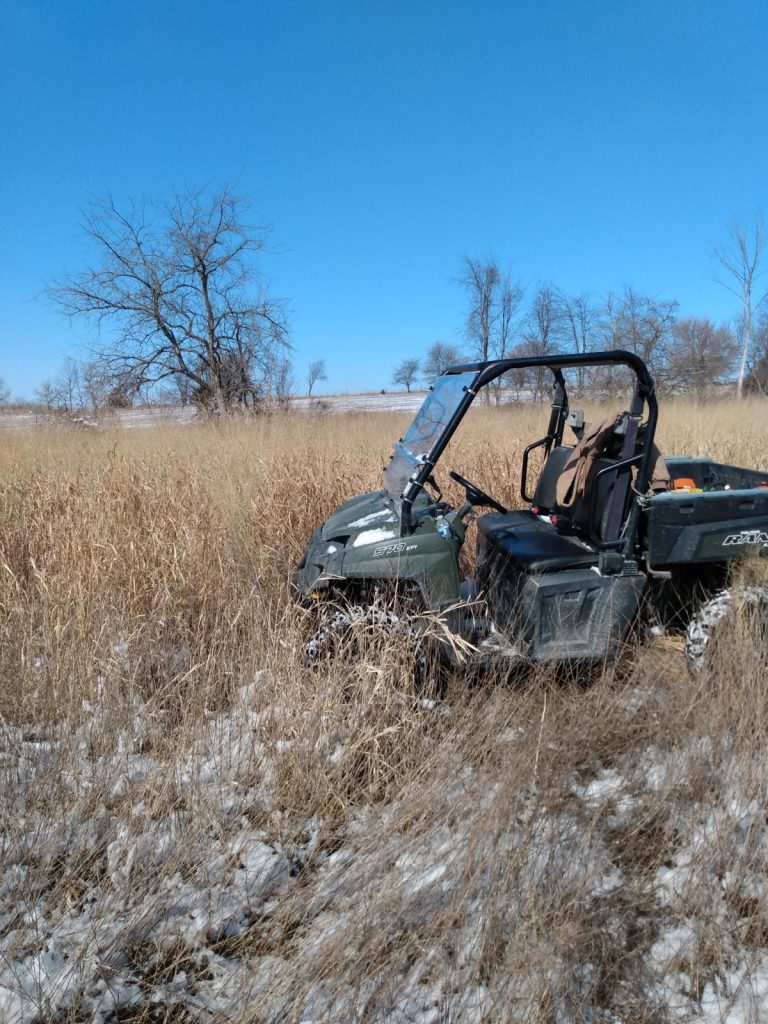
This is 2 year old cave-in-rock switchgrass planted behind the house in our bottom ground. There was just reeds canary grass in here before. Reeds canary lays down in falll giving very little cover. In the back ground is the CIR switchgrass here at the end of winter still holding strong and averaging 4-5 feet tall. In the foreground is just weeds where some red dogwood is planted.
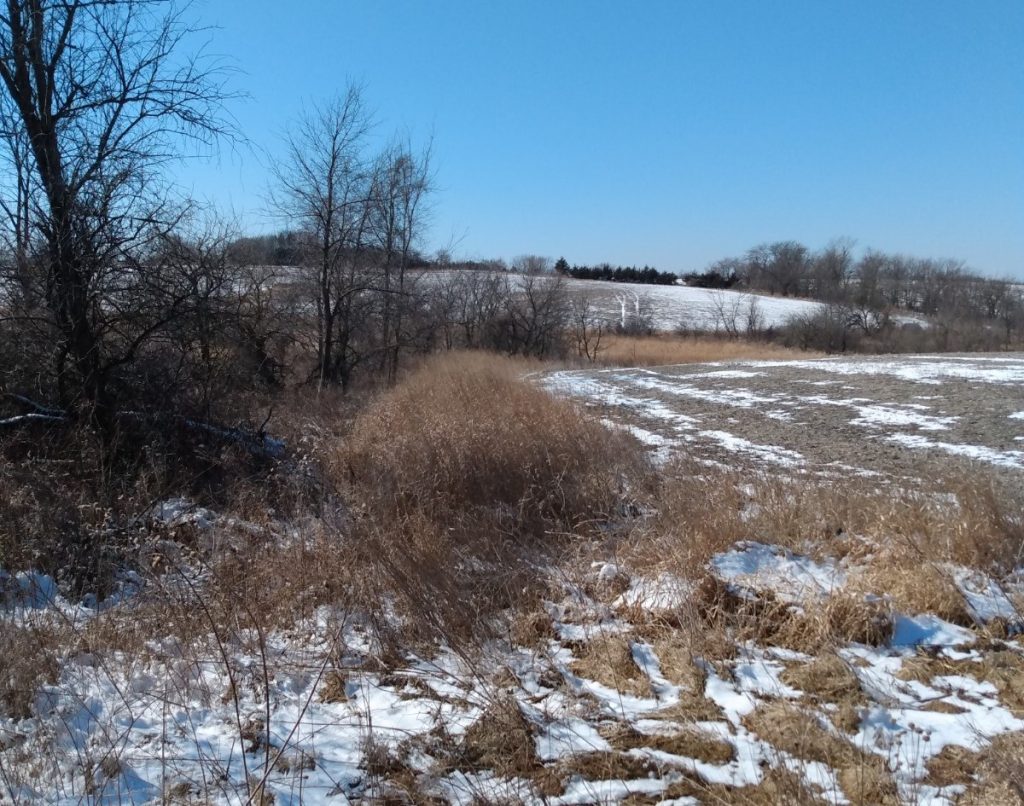
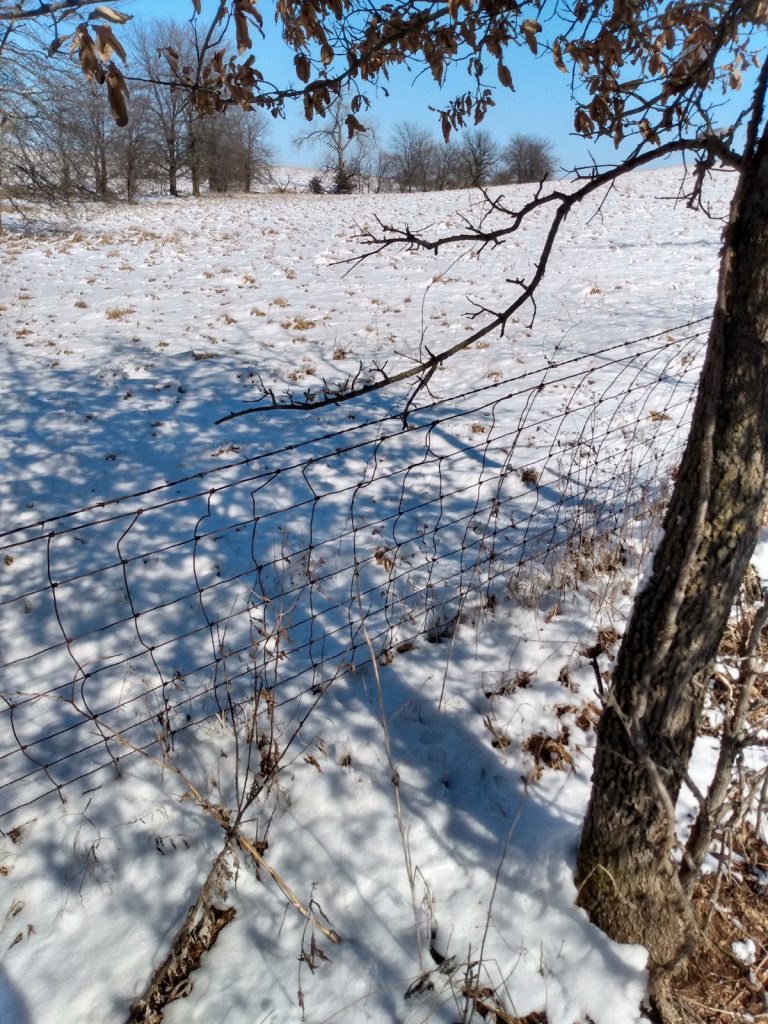
3/10/22 Over the past several days, I’ve spent some time with the chain saw doing some work at my cabin farm. I also overseeded one food plot using the frost seeding method with clover.
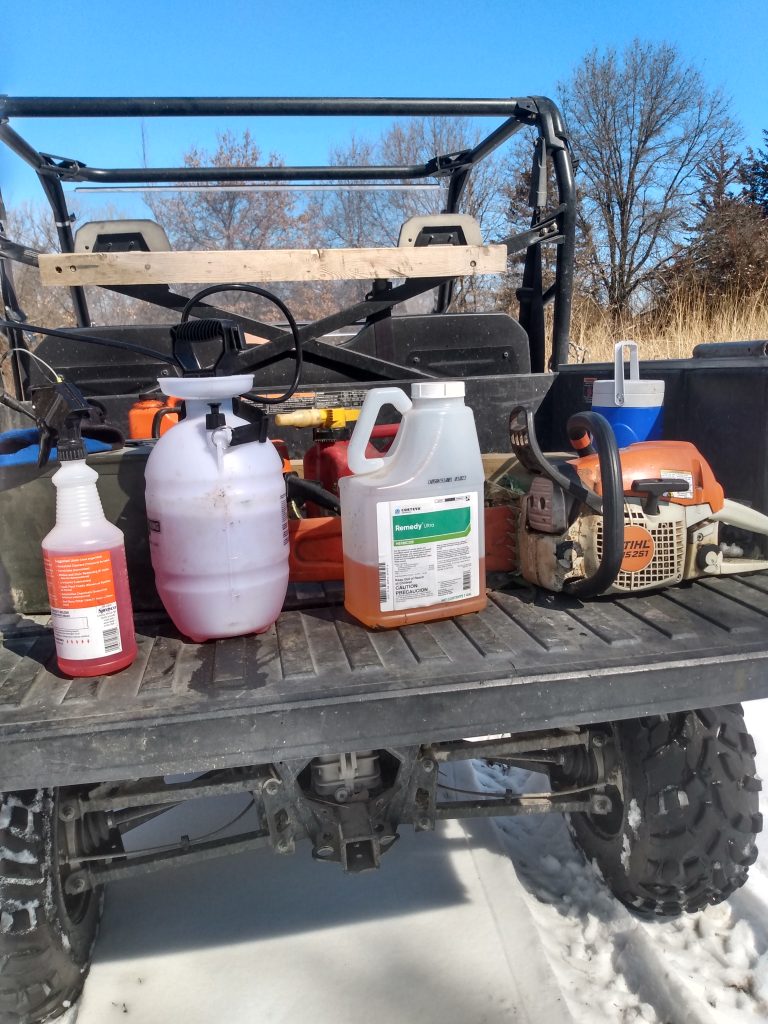
So, there seems to be some debate as to the best method on how to make a property thicker, to create cover or bedding cover that is. Should you just cut trees down? What about the hinge cut? What about girdling or hack and squirt? Some You Tube stars seem to think is has to be one way or the other, or they have an angle to why they have the best way. My thoughts are this, I’ve seen the way deer like their thicker spots in the woods, where they like to bed, and all I’m trying to do is replicate what they prefer. That’s really it. So, cutting down species of trees or trees that are curved or bent will immediately open up the overhead canopy allowing sunlight to the forest floor so that new young growth can come up in the form of browse, brambles, etc. If that tree is an unwanted species (for me that’s honey locust, black locust, or shagback hickory…maybe hackberry), then I will treat the stump with Remedy so that the tree doesn’t come back.
The problem with cutting down those trees is the potential to make the area too thick too fast. I have some areas where I am literally taking out 95% of the trees (like groves of hickory). If I were to drop all those trees, you wouldn’t be able to walk through at all, it gets too thick too fast and deer won’t even use it. That’s where girdling comes in. In those areas, I can run my saw around the tree, treat the girdle with Remedy, and the tree dies but without creating an imprenetrable mess for me and the deer. The tree dies and falls piece by piece. An interesting note: I saw a You Tube star once claim that if you did this, that when the trees die and start falling to the ground a little at a time, that you are creating a huge safety issue from the falling stuff so bad that deer won’t use that area. Another example of overthinking and drama!
Then there are areas that I am only taking out some trees because there are more desirable trees in that area like walnut or oak, and the amount of cover is not adequate enough. OR, areas where I am harvesting a ton of trees but removing them from the woods. In both cases, I am left with no horizontal cover at all. In these areas, hinge cutting works great to cut out canopy, and then immediately create side cover.
So which is best? All of the above! A balance of opening up canopy to bring in light, along with horizontal cover on the ground through downed trees or hinges provides the best cover for deer. And they love it.
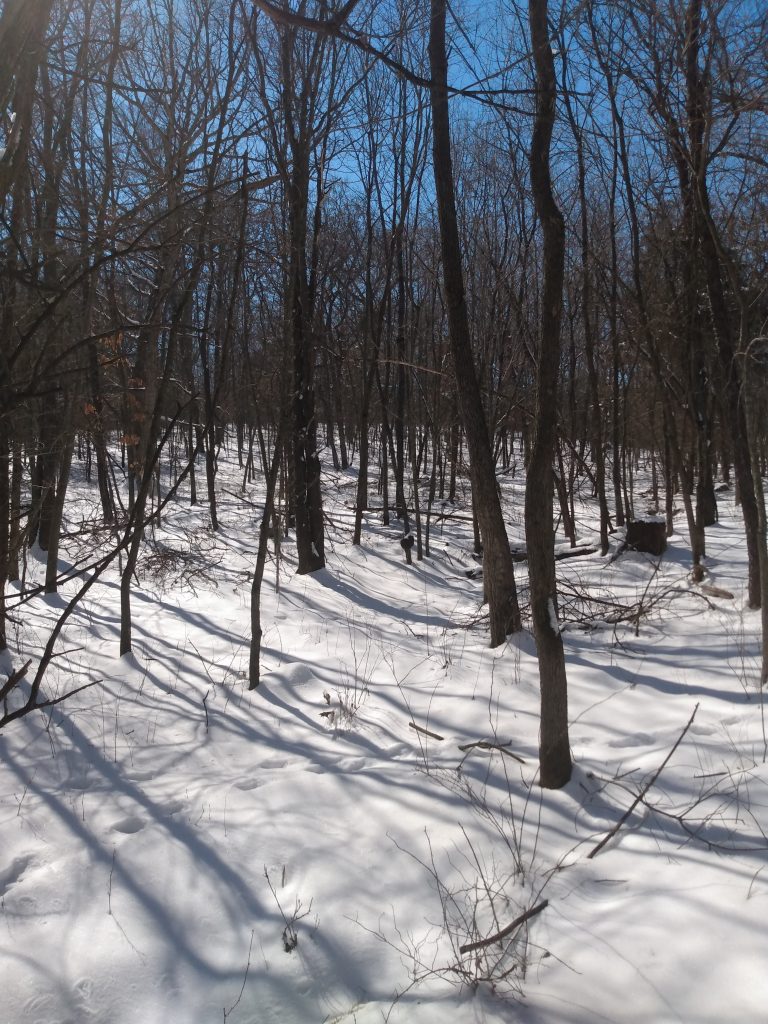
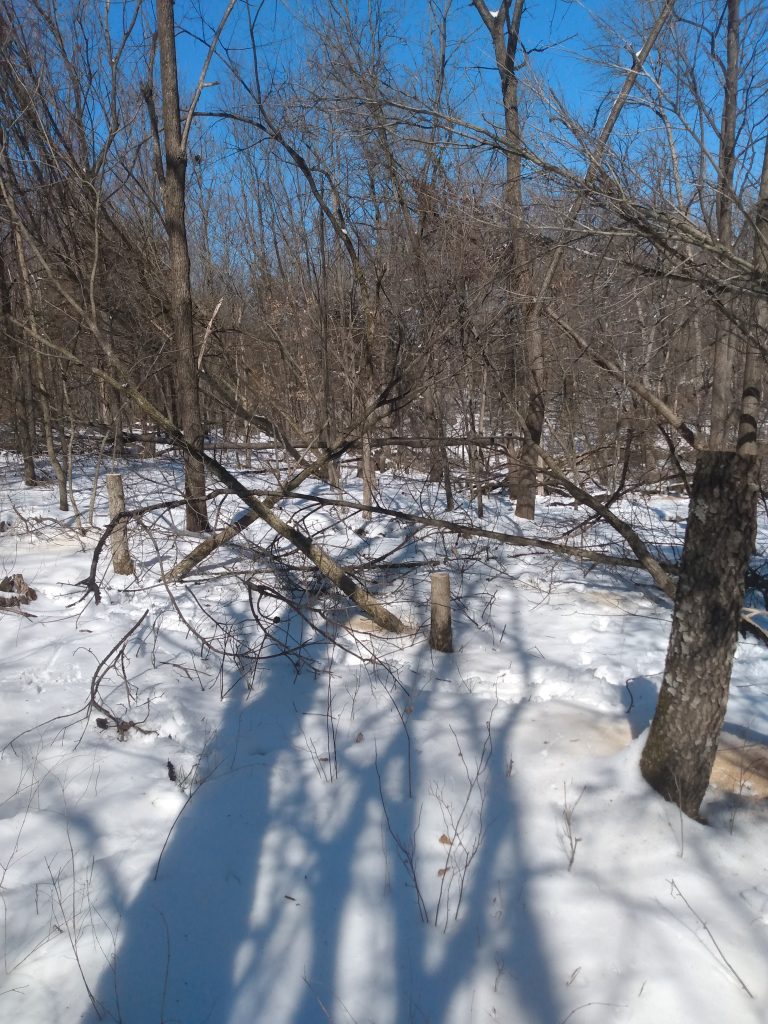
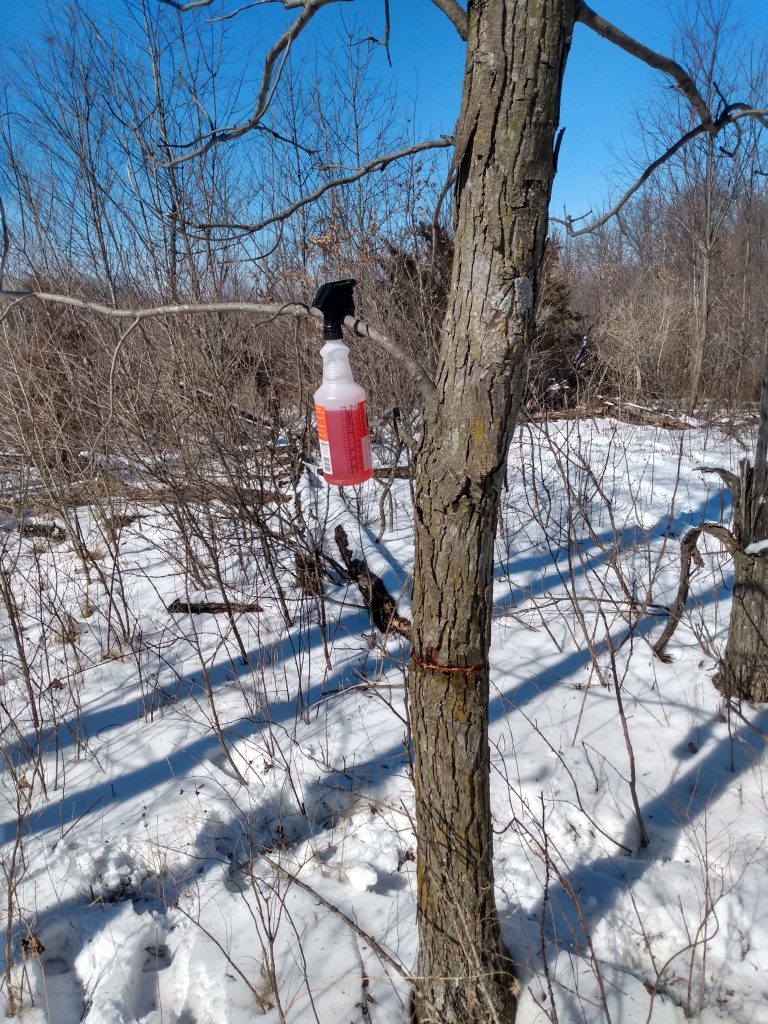
03/20/22 Spent some time this past week with an experiment where I cut dogwood bolts from clumps in the ditches around home, then just push them in the ground into areas out on the farm where I would like woody browse. In this case, it’s mostly wet areas that have reeds canary in it now. I have read, that up to 25% of the bolts will survive. That sounds low, but I did about 200 an hour. It’s very easy, just cut the bolts, and then push them in the ground in the place you want. Very fast and easy. At 25%, with that many that I can do, it’s well worth the effort and free! I’ll then go back in later spring and spray the grasses so that they won’t compete with the new bolts. Clethodim of Fusilade DM works good for this.
03/28/22
Did a ton of habitat work on the cabin farm the past few days. Mostly just continuing with more perimeter trails and creating pockets of cover.
So, in explaining a perimeter trail!!! What I have found, or observed, is that when you have a thicker piece of timber, thick enough that walking through it can be difficult at times, like a nasty bedding area with hinge cuts, and a lot of what I would call side cover, that deer often times like a nice easy path to walk down where they can go in and out of that cover easily. This seems like it allows them easy access to the cover they want, yet gives them diversity within the thick cover. I’ve observed this naturally and when hunting parcels that have been logged. So, all I’m trying to do is repeat what I have observed that really works well to funnel deer past a stand or two. I call it a perimeter trail because I’ll take a thick stand of cover, or make a thick stand of cover, then cut a trail around the outside edge of it where I can locate stands or transition plots to hunt over. This allows me to hunt the thick cover without going into it and burning it out. Access to stand sites are great, and it allows me to hunt the downwind side of the cover for any wind direction.
I’ll make the trails winding through the cover just inside or on the edge of the cover, then place my stands so that I can shoot to that trail. Sometimes, I’ll locate a very small food plot (transition plot) with a mock scrape near the stand just as a way to attract deer within that stand locations round house. It works great. I’ll go ahead and put in my mock scrape right now so that I don’t have to go back later to put it in. Deer will use the mock scrape as soon as they find the branch hanging down. I’ll typically use an oak branch, or hedge apple branch because they last the longest. A vine can be used too, or cedar branch, or anything else really that you can hang down vertically. I’ve seen YouTube stars and others claim it has to be a vine, or rope…it’s all bullshit! Conveniently, so many times when these “stars” claim is has to be one thing or another, it just so happens they are sponsored by some product they can now sell you, or claim that they are some genious inventors of that method. Deer will scrape under any branch that I hang down where I want them too. Don’t buy into the bullshit!
Then, along that perimeter trail, on the inside of that cover, when I find a tree I want to release (you’ll hear this called timber stand improvement) I can then make a pocket of cover around that tree or trees creating a pocket of thick cover where deer can bed or browse all along that perimeter trail Perpendicular dropping trees along the trail also helps funnel deer past your stand.
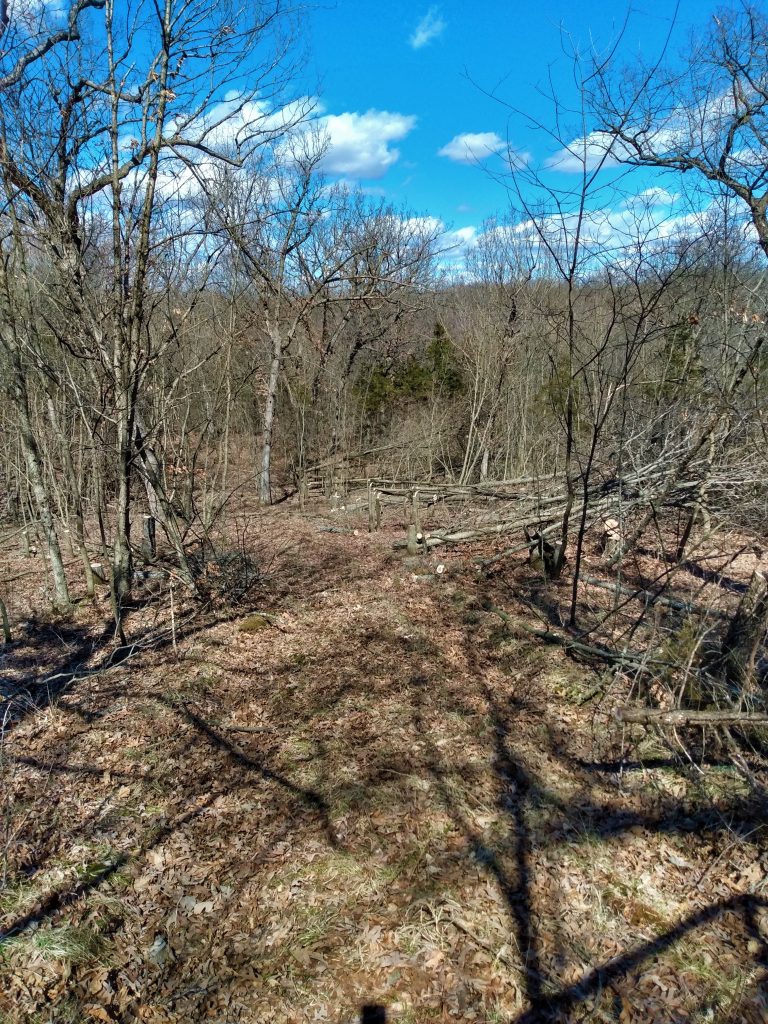
It’s hard to show in a picture how a perimeter trail should look. But it should be located on the perimeter of thick cover in a winding fashion. I like to find my tree stand spot first, taking into account access to that spot, then conveniently located or run the trail within bow range of that tree stand location. All habitat work should be done with a purpose. 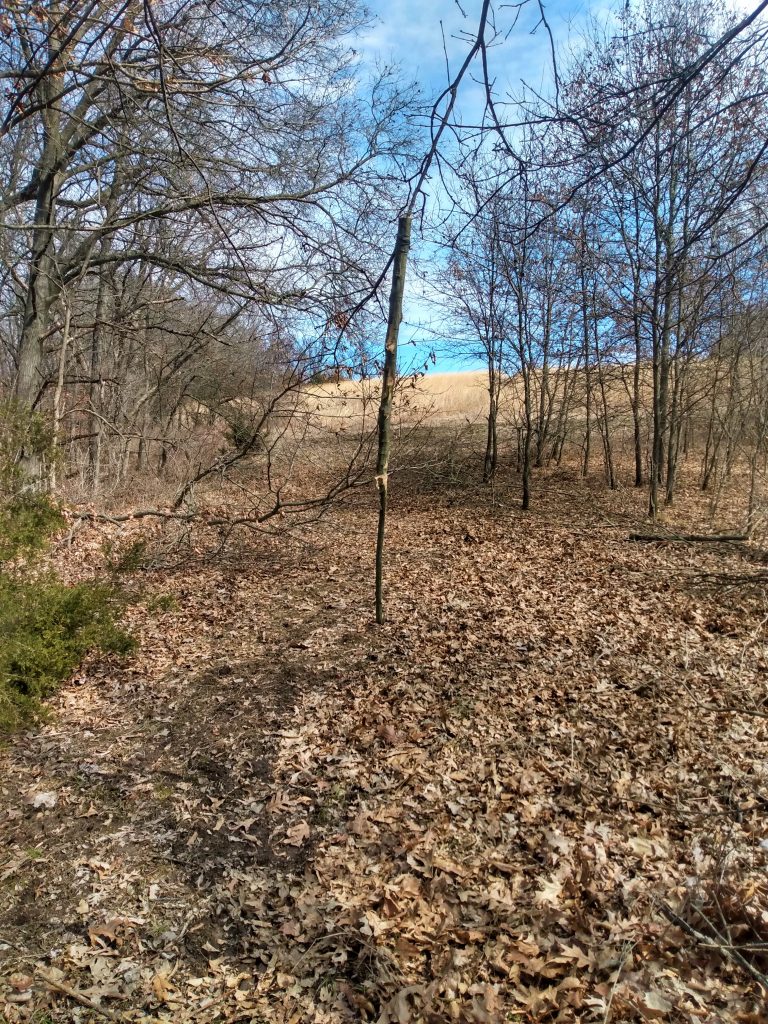
A mock scrape located near the end of one of the perimeter trails leading out to food. A perfect spot for a transition plot. I use an oak branch for this mock scrape.
I also did some burning. I don’t use burning a lot just because I don’t have a crew of people to do burns safely. But, I wanted to burn a draw behind the house to get rid of a ton of tree tops in that draw that were created by me cutting down a bunch of honey locusts the past couple years. The locust tops were hindering deer movement they were so thick, so I burned them out.
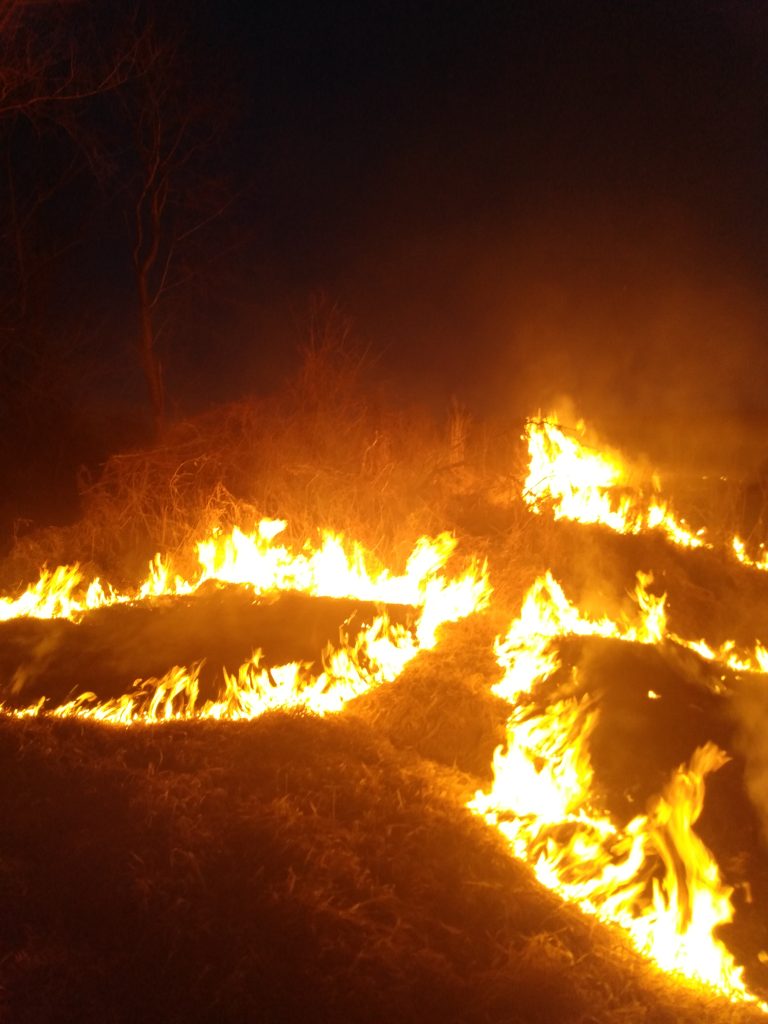
03/30/2022 Did a ton more work out at the cabin farm this week. Still finishing a bunch of cutting. Cut wanted to update a little. So, the perimeter trail is mostly done in one section of the farm with multiple branching trails. Some of the smaller trails leading through the thick cover are more in circles, others just weave in and out of cover and to the perimeter trail. The perimeter trail itself winds past three different stand spots, one for a southern wind, another a northern wind, and a new spot for an easterly wind. The south wind and now east wind spots I will also be putting in a very small interior plot meant to attract deer within bow range along my trail. A mock scrape will be at all three stands of course.
These trails are not to be used but only during the habitat season as I call it. Once my habitat work is done, I won’t use, look at, hang cameras, nothing on those trails. This keeps human pressure low on the farm. They are perfect for doing more habitat work in future years, or even getting a buck out at harvest time…but they will NOT be used at all other than that. I will mow them once a year to keep brush from taking them over and this will be done in late winter.
The small interior plot I’m putting in at the new stand required some tree clearing. Mostly bigger hickories. In the past, years ago, this work would have all been done by hand mostly. Cut the trees down and block them up into manageable pieces, then remove them by hand. Now, I have a more compact tractor that I use to help me to simply push the tree to the side. These plots are very small, maybe 10 yards wide, 20-30 yards long. They are not meant to feed deer per say, but more of a focal point for deer to come by, nibble a bit, use the scrape, then bed back down. Good all day spot!
Because of this, the plots do not have to be perfect. Once the trees are removed, then come the stumps…I’ve found the best way to remove the stumps is to not remove them at all. Just cut them flush to the ground as you can, treat them so they don’t resprout, and in a few years they’ll rot sure enough. I’ll use a disc for tillage if needed and it rides right up and over the stumps. Been doing this for ever and it works. Don’t waste a bunch of time and money buying implements or hiring people to remove or grind down stumps. Unless you have unlimited time and money!
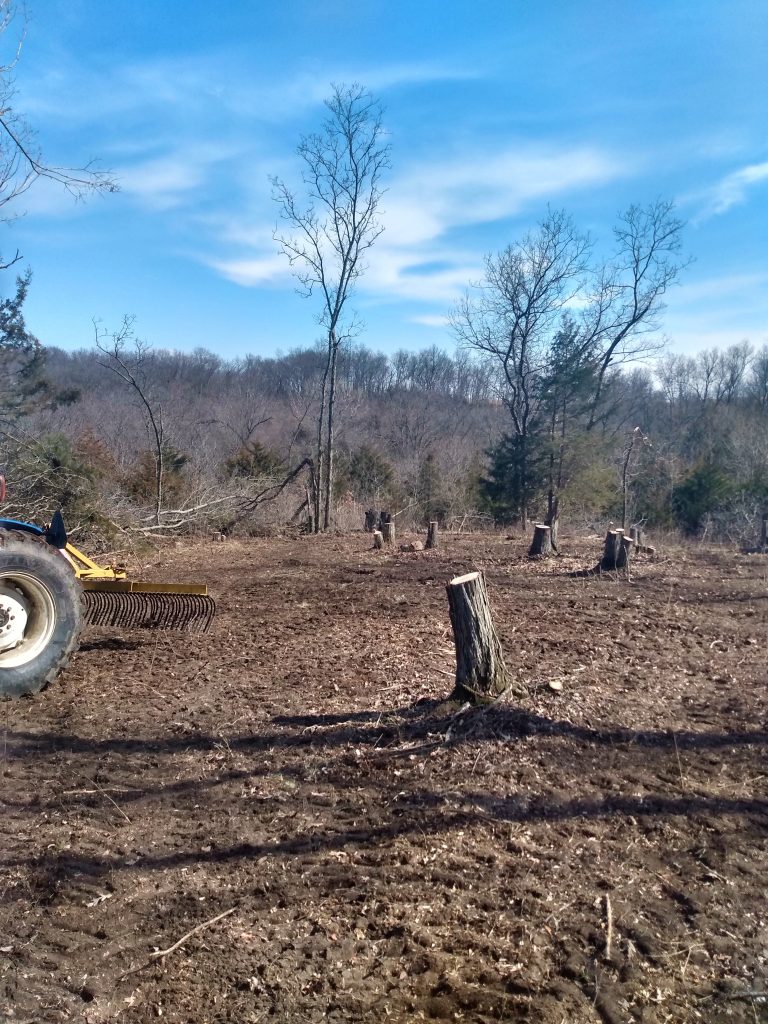
This plot is about 10-20 yards. The stumps will be cut off, treated, but not removed. 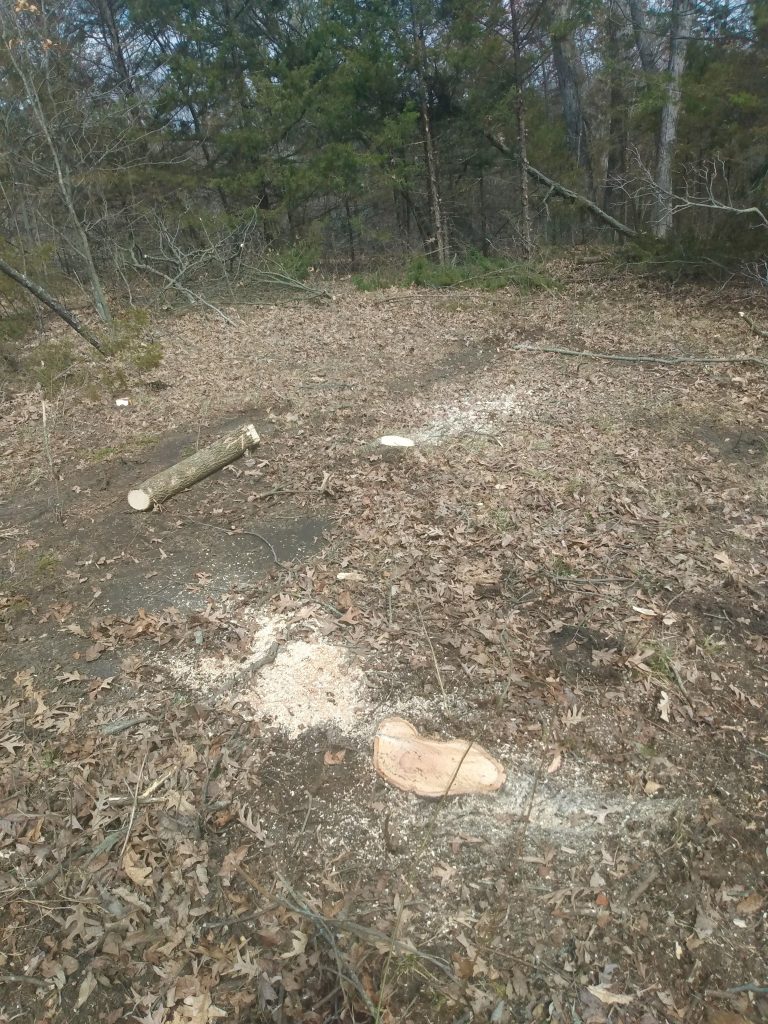
Cut stumps flush and treat. A disc will ride right over them. 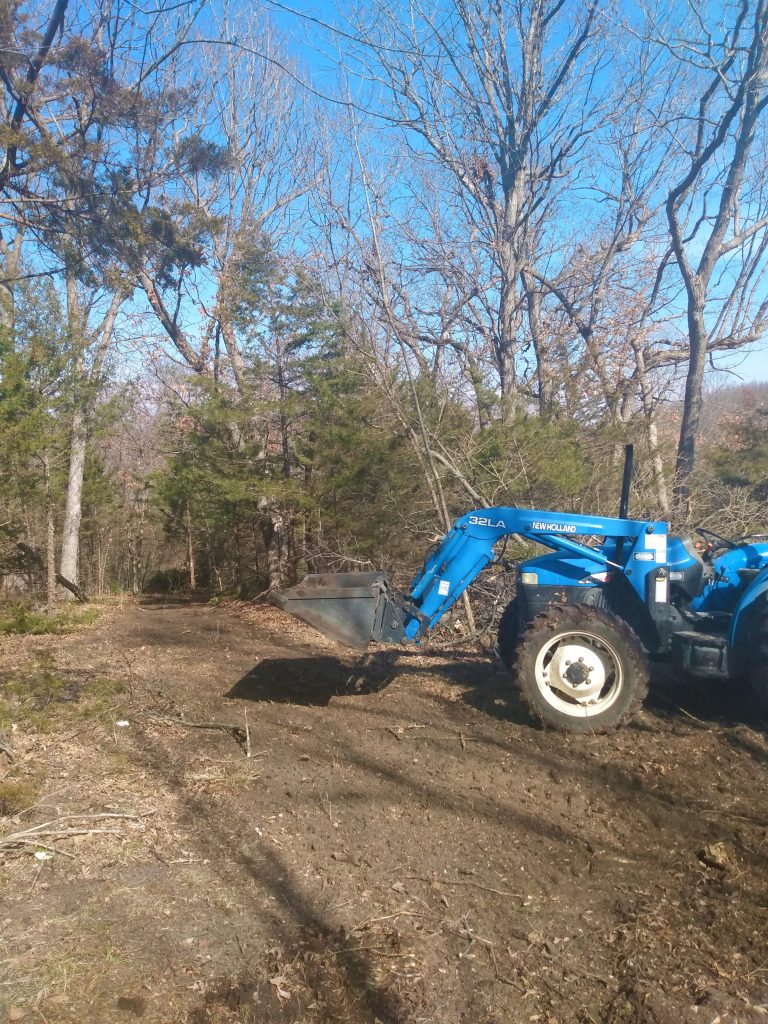
The perimeter trail entering the plot is done in this area. 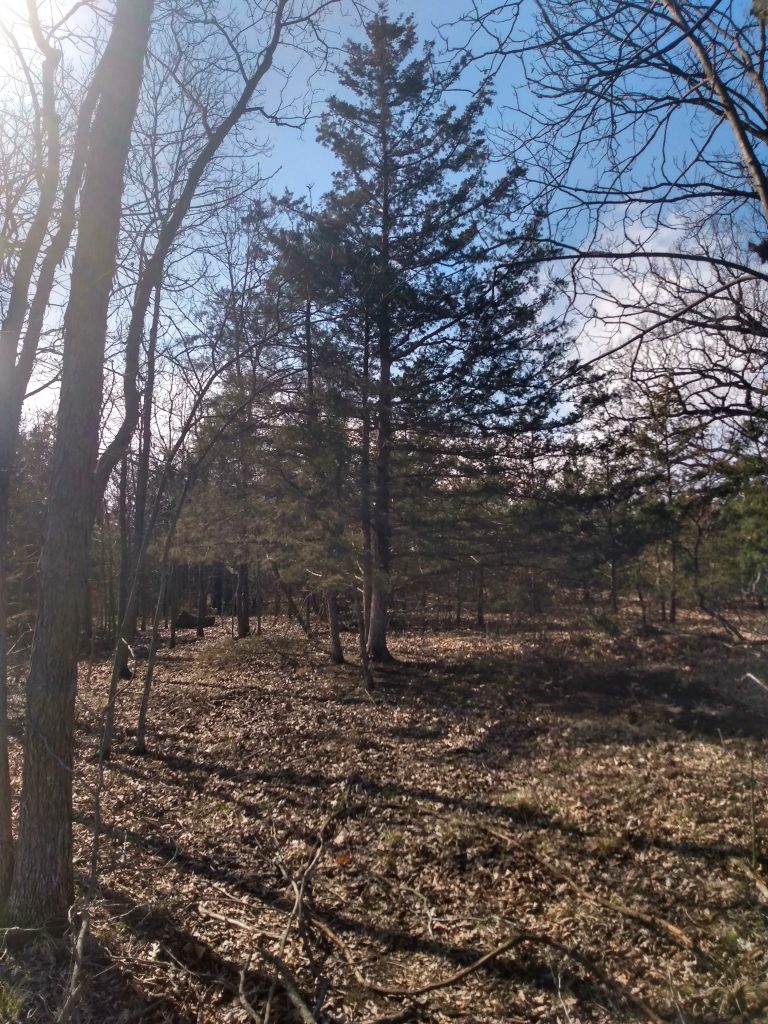
I needed an east wind spot on the farm. I picked this tree out, planned the interior plot, perimeter trail, all first before starting the work. This cedar offers perfect access to the stand, perfect for an east wind, and it allowed for the trail swinging by within range plus the food plot.
You’ll see that in some of the pics I have used a land rake to remove debris from the plot. I’ve done this because I already have on of these. If you don’t, you can leave smaller debris right in the plot. It won’t hurt a thing. Deer don’t care!
4/11/22 Well, habitat work for the year is coming to an abrupt end. I have been hitting it hard this year doing a ton of cuttings, forest improvement work (releasing oak and walnut mostly), cutting a ton of hickory, creating trails through cover, and today I finished the season up by burning a draw behind the house.
The goal with the burn was to burn down a bunch of tree tops that I had pushed into that draw a few years back already. Instead of taking the time then, and all the work, to make sure the tops didn’t create bottlenecks and ways the deer couldn’t travel the draw, I just cut them and pushed them years ago with the intention of always coming back and burning. The burning won’t necessarily burn all the tops down to nothing, but it will burn most of the smaller branches and the tops will then settle making it easier for deer to travel. I had tried burning this draw a few weeks back, but it was too cold and wet. Burning went good today.
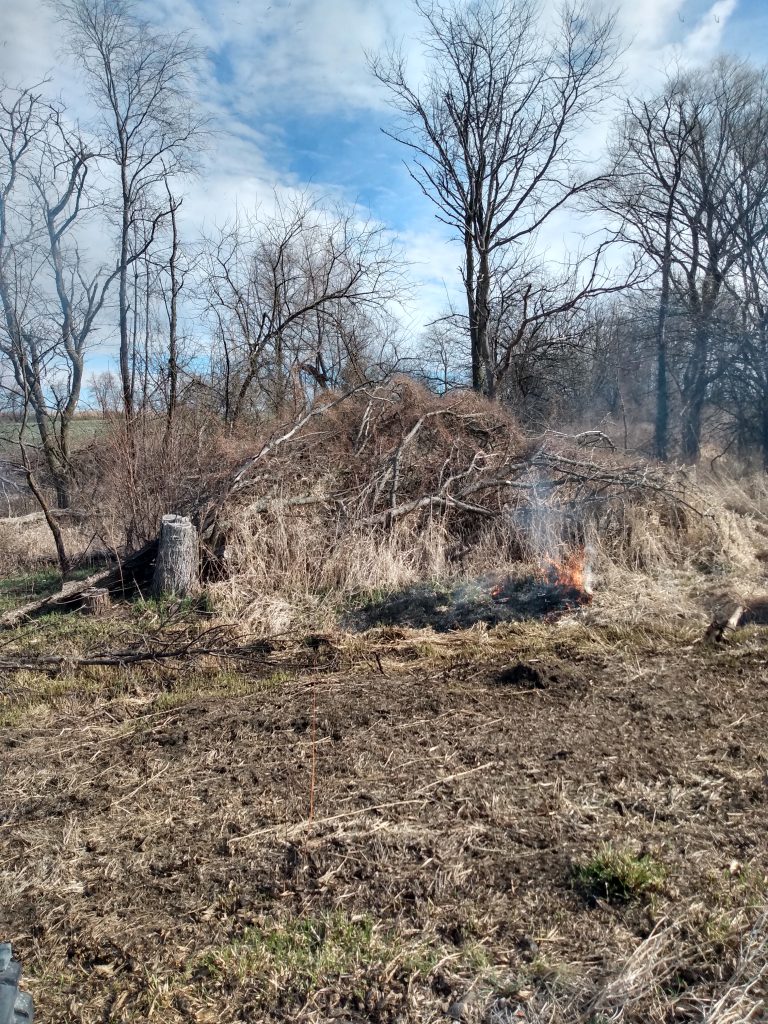
These brush piles, if too thick, will deter deer from using the area. I’ve noticed that deer won’t use this draw maybe as good as they did before I did all the cutting. But, after this burn today, new woody browse, briars, grasses, and other good cover type species will explode in this area. This pile might still be there, but way more settled down and less “blocking”. 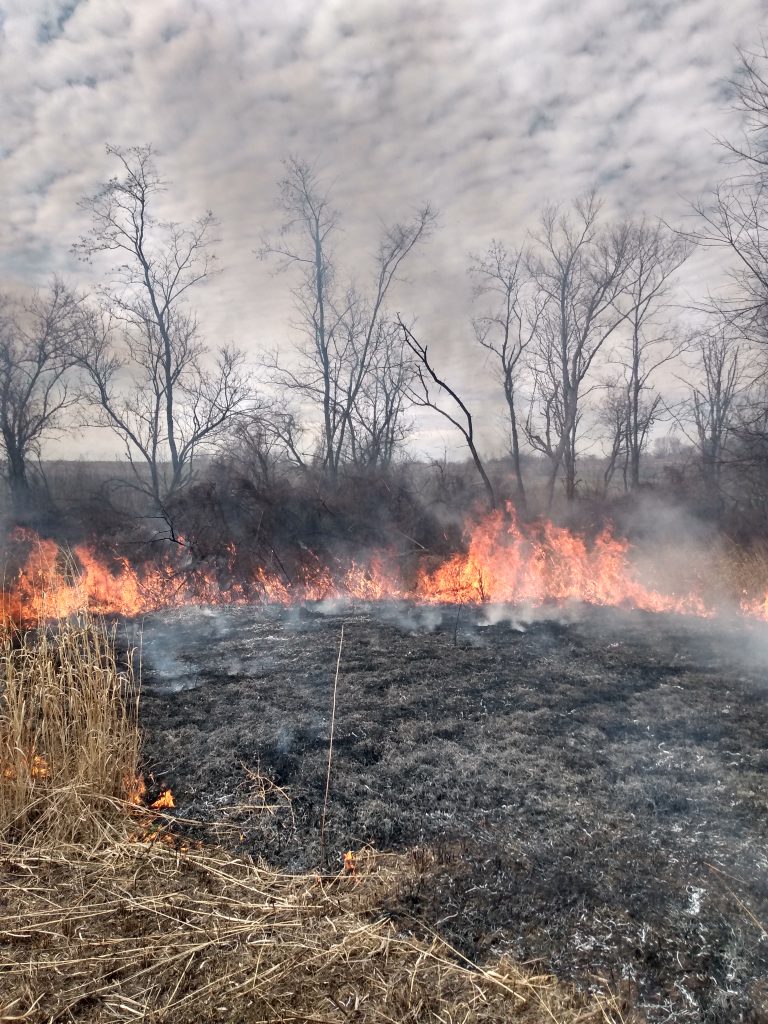
The grass is the fuel for the fire, when the burn was done, most of the brush went with it. I don’t burn a lot mostly because I’m cautious and afraid of something getting away, but it is a great tool when used correctly.
The only other thing I did since the last post was a consultation in Northern Missouri. It was a really pretty mixed agriculture farm with a ton of potential. The land owner I feel is a good hunter, but thought it wise or prudent to get my opinon before going nuts with habitat and other work. It was a great day, and as is always the case, by the end of the day I could feel myself getting exited for this hunter/landowner. A great habitat and hunting plan was put in place for this nice farm!!!
I think that’ll be all for the off-season habitat blog. I have spring planted soybeans and corn going in soon. I hope even though this blog isn’t very long that you maybe picked up a thing or two.
2021 Year in Review
Gallery
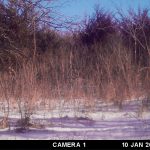
This gallery contains 1 photo.
2021/2022 was another great year for our family and Full Potential Outdoors. Going into the season, there were 4 of us going to hunt. I would be hitting the archery season and late muzzleloader seasons hard. Amy would end up … Continue reading
Crabby Crashes
Gallery
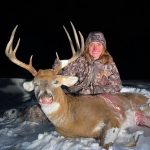
This gallery contains 2 photos.
01/02/2022 Lily had an awesome hunt. We saw a ton of deer and last night she nailed a brute mature buck we called Buster. With her still in camp, I told Amy she needed to go with me and keep … Continue reading
Buster Bites the Bullet
Gallery
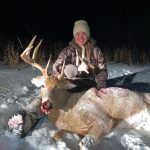
This gallery contains 1 photo.
I’ll have to admit, Lily’s late season muzzleloader hunting in 2021/2022 has been great. We’ve been on deer on every hunt, but something always seemed to go wrong. Maybe that’s the wrong way to look at it, but with all … Continue reading
2021/2022 Late Muzzy Updates
Gallery
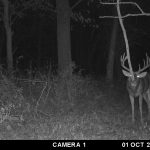
This gallery contains 7 photos.
So, again this year I’ll be running a daily (hopefully daily) late muzzleloader blog. I can honestly say, I don’t have a single deer I will be targeting this late season. There are a couple reasons for this. First, there … Continue reading
BBD Scarback Presses His Luck
Gallery
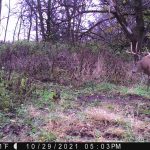
This gallery contains 3 photos.
In 2019, I first saw this buck that I nicknamed Scarback. He was 4 years old then and had this huge patch of hair missing from his back. (Thus Scarback). We played a game of cat and mouse that year … Continue reading
BBD Swoops Makes Mistake
Gallery
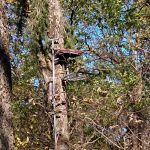
This gallery contains 1 photo.
11/7 5pm So, going into 2021 I had the same goals for my hunting season I always have. That is, to maximize the time I get to spend in the field hunting, and to be able to hunt big deer. … Continue reading
2021 Archery Updates
Gallery
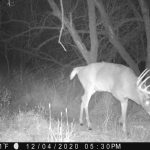
This gallery contains 1 photo.
10/1 Today of course marks the Iowa season opener for early archery. This year will be somewhat different for me than years past. First, Amy will be archery hunting this year for the first time in a very long time. … Continue reading
2020 Archery Updates
Gallery
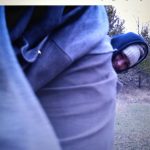
This gallery contains 49 photos.
I will attempt to once again this year post updates on the 2020 archery hunt. Right off the bat, I am having difficulty loading images. So, when I figure that out I’ll get some pics on here to make things … Continue reading
2019 Archery Updates
Gallery
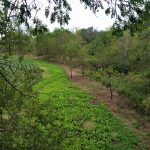
This gallery contains 1 photo.
I am going to try and provide up to date posts about this archery season. Tonight was season opener, major storms coming in, flash flood watches/warnings…but you gotta go on opening day. Saw 11 does and fawns, one 2 year … Continue reading
Mega Giant
Gallery
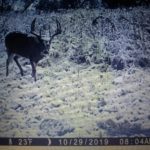
This gallery contains 3 photos.
(Story told through the eyes of an outfitter) In 2016, in the later parts of winter, I traveled 7 hours from my then home in Wisconsin to check on a farm in southern Iowa I was interested in buying. It … Continue reading
Rut Timing Podcast
Gallery
I have some pretty strong opinions about the timing of the rut. I did a podcast talking about this. Have a listen. https://sportsmensnation.com/podcasts/when-to-hunt-the-rut
Habitat Podcast #1
Gallery
The other day, I did a first in a series podcast with Dan Johnson (Nine Finger Chronicles) on the Sportsmen’s Nation. Give a listen! https://sportsmensnation.com/podcasts/deer-habitat-improvement-with-tom-peplinski
2018 Late Muzzleloader Blog
Gallery
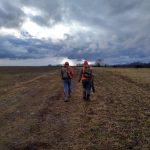
This gallery contains 6 photos.
12/26 12:04 pm. As in 2014, and again in 2016, I will be running a daily blog of the Late Muzzleloader hunt. This year, my daughter Lily has a tag and has traveled down from Wisconsin with my son Forest … Continue reading
Pre-Rut Podcast
Gallery
It’s October 25th, my favorite time of year. If you like hunting this time of year and would like to see me take on it, you might want to check out this podcast I did for Iowa Sportsman Magazine. The … Continue reading
6 1/2 Year Old Goes Down
Gallery
Last night, 10/20, as the wind blew from the NW with gusts approaching 40 MPH, Mark took to the timber in an interior plot I call “The Boot”. Year in and year out this is a great spot, … Continue reading
2016 Late Muzzleloader Blog Updates
Gallery
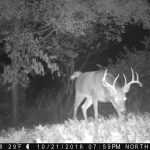
This gallery contains 17 photos.
In 2014 my son Forest took the late muzzleloader spot and after less than an hour of hunting, took a nice mature buck we had nicknamed Captain Jack. In 2015, the late muzzleloader season was met with some unseasonably warm, … Continue reading
The Hunt for “Cross Over”
Gallery
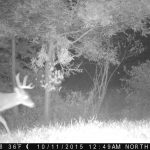
This gallery contains 3 photos.
Joel’s hunt this year was really not what he had planned. It all started in mid summer when the results for the Iowa draw came in…he drew a tag but hunting partner Mike did not draw. They had planned on … Continue reading
We’re Getting Close
Gallery
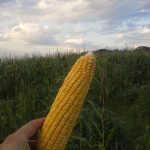
This gallery contains 4 photos.
So far this year, the work on the farm has been mostly the same as in years past. Spring food plots…followed by spraying…late summer brassicas. It’s the same routine pretty much year after year once I get a farm to … Continue reading
2015 Year in Review
Gallery
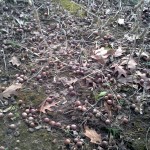
This gallery contains 4 photos.
2015 Year in Review At the end of each hunting season, I review how the year went. What worked? What didn’t? What ideas paid off? What things new did I learn this year? It’s a critical self-assessment any good hunter … Continue reading
Patience….Pays Off!
Gallery
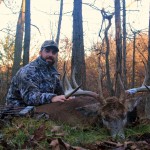
This gallery contains 1 photo.
I never know what to think when meeting a hunter for the first time. Are they for real? Do they have what it takes to stay patient and put together a good hunt? Well, many hunters truly believe they are … Continue reading
Peak Hunting Success
Gallery
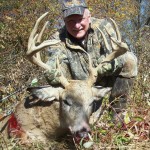
This gallery contains 1 photo.
I’m not very shy about expressing my opinion each and every year that peak hunting has always been for me around Halloween. I love that time frame from about the 20th of October ramping up hard by the 25th…and then … Continue reading
Fall Plots In
Gallery
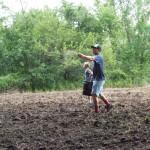
This gallery contains 2 photos.
On Monday and Tuesday of this past week I was privileged to have two of my nephews on the farm with me putting in fall food plots, trimming shooting lanes on stands, creating exit and entrance routes to stands, and … Continue reading

